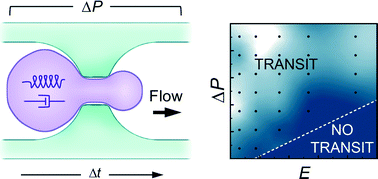The physical origins of transit time measurements for rapid, single cell mechanotyping†
Abstract
The mechanical phenotype or ‘mechanotype’ of cells is emerging as a potential biomarker for cell types ranging from pluripotent stem cells to cancer cells. Using a microfluidic device, cell mechanotype can be rapidly analyzed by measuring the time required for cells to deform as they flow through constricted channels. While cells typically exhibit deformation timescales, or transit times, on the order of milliseconds to tens of seconds, transit times can span several orders of magnitude and vary from day to day within a population of single cells; this makes it challenging to characterize different cell samples based on transit time data. Here we investigate how variability in transit time measurements depends on both experimental factors and heterogeneity in physical properties across a population of single cells. We find that simultaneous transit events that occur across neighboring constrictions can alter transit time, but only significantly when more than 65% of channels in the parallel array are occluded. Variability in transit time measurements is also affected by the age of the device following plasma treatment, which could be attributed to changes in channel surface properties. We additionally investigate the role of variability in cell physical properties. Transit time depends on cell size; by binning transit time data for cells of similar diameters, we reduce measurement variability by 20%. To gain further insight into the effects of cell-to-cell differences in physical properties, we fabricate a panel of gel particles and oil droplets with tunable mechanical properties. We demonstrate that particles with homogeneous composition exhibit a marked reduction in transit time variability, suggesting that the width of transit time distributions reflects the degree of heterogeneity in subcellular structure and mechanical properties within a cell population. Our results also provide fundamental insight into the physical underpinnings of transit measurements: transit time depends strongly on particle elastic modulus, and weakly on viscosity and surface tension. Based on our findings, we present a comprehensive methodology for designing, analyzing, and reducing variability in transit time measurements; this should facilitate broader implementation of transit experiments for rapid mechanical phenotyping in basic research and clinical settings.


 Please wait while we load your content...
Please wait while we load your content...